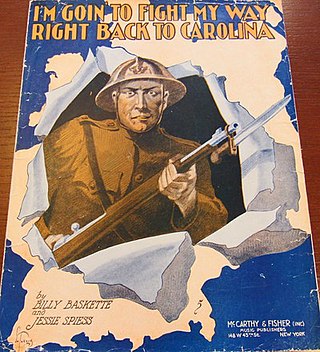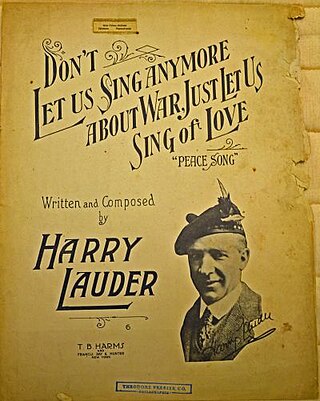
Soldier Boy is a World War I era song released in 1915. D.A. Esrom wrote the lyrics. Theodore Morse composed the music. Leo Feist, Inc. of New York, New York published the song. Artist Harry Lewis designed the cover art for the sheet music. On the cover, there are three cartoon soldiers. One has his head turned to kiss a woman behind him. The song was written for both voice and piano. It is told from the point of view of a woman who is proud of her soldier boy. She addresses the soldier directly in the chorus:

"My Sweetheart Is Somewhere in France" is a World War I era song first released in 1917. Mary Earl composed the music and wrote the lyrics. Shapiro, Bernstein & Co. Inc. of New York City published the song. Elizabeth Spencer performed a version of the song that was released by the Victor record label.

"Send Me a Line When I'm Across the Ocean" is a World War I era song first released in 1917. Irving Crocker wrote the lyrics. George L. Cobb composed the music. It was written for both voice and piano. Walter Jacobs of Boston, Massachusetts published the song. The cover was designed by Rose Starmer. On the cover is a watercolor painting of an ocean with ships in the background. In the foreground is an envelope addressed: "Private Good-boy; Rainbow Division; Somewhere in France."

"Gee! What a Wonderful Time We'll Have When the Boys Come Home" is a World War I era song released in 1917. Lyrics and music were written by Mary Earl. The song was published by Shapiro, Bernstein & Co. of New York, New York. It was written for both voice and piano. The sheet music cover was designed by artist Albert Wilfred Barbelle. On the cover are soldiers marching down a city street. A skyline is behind them, and the lights spell out, "Welcome Home."

"There's a Green Hill Out in Flanders " is a World War I era song released in 1917. Lyrics and music were written by Allan J. Flynn. Al Piantadosi & Co. of New York City. The song was written for both voice and piano.

"It's a Long, Long Way to the U.S.A " is a World War I era song released in 1917. Val Trainor wrote the lyrics. Harry Von Tilzer composed the music. The song was published by Harry Von Tilzer Publishing Company of New York, New York. It was written for both voice and piano.

"I'm Goin' To Fight My Way Right Back to Carolina" is a World War I era song written and composed by Billy Baskette and Jessie Spiess. The song was published in 1918 by McCarthy & Fisher, Inc. of New York City. The sheet music cover was designed by Andre C. De Takacs. It features an armed soldier tearing through the cover. The song was written for both voice and piano.

"So Long, Mother" is a World War I era song released in 1917. Raymond B. Egan and Gus Kahn wrote the lyrics. Egbert Van Alstyne composed the music. The song was published by Jerome H. Remick & Co. of Detroit, Michigan. On the cover is a soldier and mother in an embrace. To the left is an inset photo of singer Al Jolson. It was written for both voice and piano.

"We Don't Want the Bacon (What We Want Is a Piece of the Rhine)" is a World War I–era song released in 1918. The lyrics were written by "Kid" Howard Carr and Harry Russell, and the music composed by Jimmie Havens. The song was published by Shapiro, Bernstein & Co. of New York City. On the cover is a soldier tearing through a large piece of bacon with his bayonet. A fearful-looking Kaiser Wilhelm II is standing on the bacon. It was written for voice and piano.

"When the 'Yanks' Come Marching Home" is a World War I era song released in 1917. William Jerome wrote the lyrics. Seymour Furth composed the music. It was published by A.J. Stansy Music Co. of New York City.

"Lorraine " is a World War I era song released in 1917. Al Bryan wrote the lyrics. Fred Fisher composed the music. It was published by McCarthy and Fisher, Inc.. André De Takacs designed the sheet music cover. It features a French soldier with his bayonet drawn in the foreground. A woman, who is a symbol of Liberty, and child look on behind him. The song was written for voice and piano.

"Somewhere in France Is Daddy" is a World War I era song released in 1917. Lyrics and music were written by "Great Howard," otherwise known as Howard Miller. It was published by Howard & LaVar Music Co. of New York, New York. There are two versions of the sheet music cover. Both feature a mother holding a child, soldiers firing from a trench, and an inset photo of Great Howard. The latter version is a darker blue and the photo is of Howard in kilts. The song was written for both voice and piano.

"Tom, Dick and Harry and Jack " is a World War I era song released in 1917. Howard Johnson wrote the lyrics. Milton Ager composed the music. The song was published by Leo Feist, Inc. of New York City. Artist Henry Hutt designed the sheet music cover. It features four men in different service uniforms with an inset photo of either Jack Connors, Jr. or Bailey and Cowan. The inset photo varies by edition. It was written for both voice and piano.

"Say a Prayer for the Boys "Out There"" is a World War I era song released in 1917. Bernie Grossman wrote the lyrics. Alex Marr composed the music. It was published by Joe Morris Music, Co. of New York, New York. The sheet music cover was designed by the Starmer Brothers. It features a family praying at the dinner table. Behind them is a sentry guarding a campground of tents. There is an inset photo on the left side that varies per edition. The song was written for both voice and piano.

"I Don't Want to Get Well" is a World War I era song released sometime between 1917 and 1918. Harry Pease and Howard Johnson wrote the lyrics. Harold Jentes composed the music. Leo Feist, Inc. of New York City published the song. Rosenbaum Studios designed the sheet music cover. It features a Red Cross nurse checking the pulse of a wounded soldier as he lies in his hospital bed. The two look at each other longingly. A battle is seen through the window. It was written for both voice and piano.

"After the War Is Over Will There Be Any 'Home Sweet Home'?" is a World War I–era song released in 1917. Elmer J. Pourmon and Joseph Woodruff wrote the lyrics. Harry Andrieu composed the music. The cover lists Woodruff as composer and Pourmon as lyricist. Contradictory information inside the sheet music lists Harry Andrieu as composer, and Woodruff and Pourmon as lyricists.

"Bring Back My Daddy To Me" is a World War I era song released in 1917. William Tracey and Howard Johnson wrote the lyrics. George W. Meyer composed the music. Leo Feist, Inc. of New York, New York published the song.

"Don't Let Us Sing Anymore About War, Just Let Us Sing of Love " is a World War I era song released in 1918. Lyrics and music were written by Harry Lauder. It was published by T.B. Harms and Francis, Day & Hunter, Music Co. of New York, New York. The sheet music cover features a photo of Lauder with his autograph. The song was written for both voice and piano.
Salvation Lassie Of Mine is a World War I song written by Jack Caddigan and Chick Story. The song was first published in 1919 by Leo Feist, Inc. in New York, NY. The sheet music cover features a photo of a Salvation Army nurse with soldiers entering a Salvation Army hut. This song was in the top 20 charts in March and April 1919, reaching number 18 in April.

Let's All Be Americans Now is a World War I song written and composed by Irving Berlin, Edgar Leslie, and George W. Meyer. The song was first published in 1917 by Waterson, Berlin & Snyder Co., in New York, NY.The sheet music cover depicts a soldier with his rifle and silhouetted marching soldiers in the background. A popular recording in 1917 was made by the American Quartet.



















